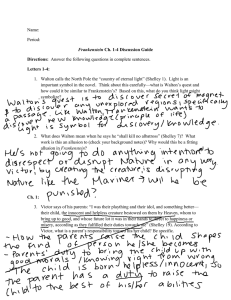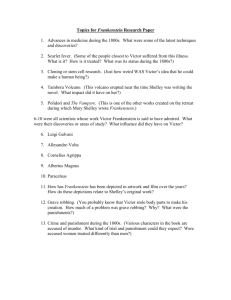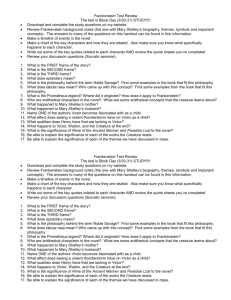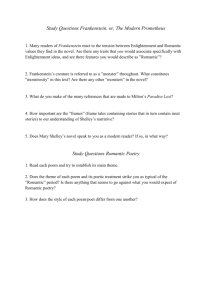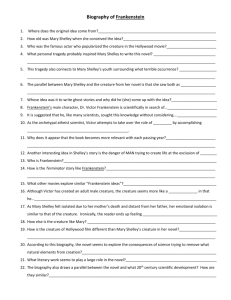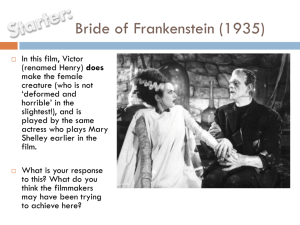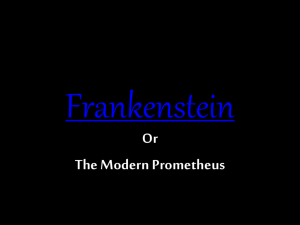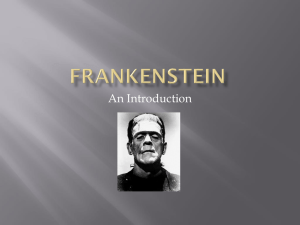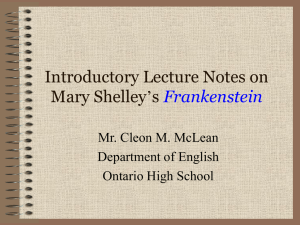Mary Shelley
advertisement
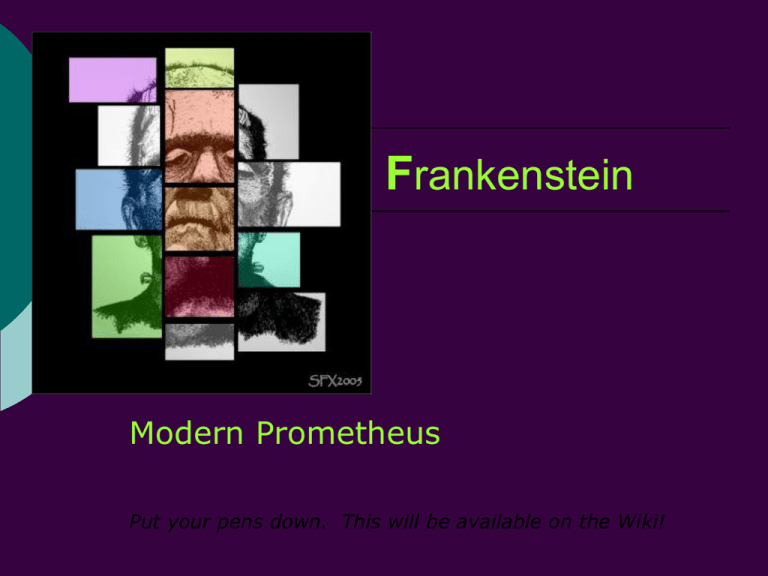
Frankenstein Modern Prometheus Put your pens down. This will be available on the Wiki! Mary Shelley Born in 1797 to William Godwin and Mary Wollstonecraft Her mother died shortly after Mary was born Shelley learned about her mother only through writings her mother left behind, including A Vindication of the Rights of Women (1792) which advocated that women should have the same educational opportunities as rights in society as men. Mary Shelley Avid reader and scholar and knew through her father some of the most important men of the time (William Wordsworth and Samuel Taylor Coleridge) Married (scandal!) Percy Bysshe Shelley in 1816 and listened intently to his intellectual conversations with others Mary Shelley On a visit in Switzerland with PBS to Lord Byron, she was challenged to write a story. She had heard Byron and Shelley discussing “the nature of the principle of life and whether there was any chance of its ever being discovered.” From this conversation, she had the “waking dream” which eventually became the novel Frankenstein. Historical Context Ambiguous Walton’s letters dated “17-” with no reference to anything specific to pinpoint the date. It is set in the latter part of the 18th century, at the end of the Enlightenment and the beginning of the Romantic period. It critiques the excesses of the Enlightenment and introduces the beliefs of the Romantics. Reflects a shift in social and political thought – from humans as creatures who use science and reason to shape and control their destiny to humans as creatures who rely on their emotions to determine what is right. Ideas of the Enlightenment Scientific observation of the outer world Logic and reason; science and technology Believed in following standards and traditions Appreciated elegance and refinement Interested in maintaining the aristocracy Sought to follow and validate authority Favored a social hierarchy Nature should be controlled by humans Important Revolutions American and French Revolution (call for individual freedom and an overthrow of rigid social hierarchy) Industrial Revolution – social system challenged by change from agricultural society to industrial one with a large, impoverished and restless working class Characteristics of Romantic Period Emphasis on imagination and emotion, individual passion and inspiration Rejection of formal, upper class works and a preference for writing (poetry) that addresses personal experiences and emotions in simple, language A turn to the past or an inner dream world that is thought to be more picturesque and magical than the current world (industrial age) Characteristics of Romantic Period Belief in individual liberty; rebellious attitude against tyranny Fascination with nature; perception of nature as transformative Characteristics of Romantic Period Concerned with common people Favored democracy Desired radical change Nature should be untamed Style: Gothic Novel Frankenstein is generally categorized as a Gothic novel, a genre of fiction that uses gloomy settings and supernatural events to create and atmosphere of mystery and terror. Shelley adds to her development of the plot the use of psychological realism, delving into the psyches of the characters in and attempt to explain why they react as they do and what drives them to make their decisions. Structure and Point of View Frame Story Epistolary – carried by letters Major Characters Victor Frankenstein – protagonist, product of an idealistic Enlightenment education; fueled by possibilities of science and a desire for acclaim; becomes obsessed with creating life from spare body parts. Rational demeanor dissolves and by story’s end, consumed by primitive emotions of fear and hatred. Major Characters The Creature - never named; is Victor’s doppelganger (alter ego); Creature rationally analyzes the society that rejects him; sympathetic character, admires people and wants to be a part of human society; only results in violence when he is repeatedly rejected Major Characters Henry Clerval – Victor’s childhood friend; true romantic, wants to leave mark on the world, but never loses sight of “the moral relations of things: Elizabeth – adopted as an infant by Victor’s family; marries Victor Robert Walton – Arctic explorer who’s obsessed with gaining knowledge and fame; rescues Victor in the Arctic; tells the story Themes Consequences of irresponsibility in the pursuit of knowledge Consequences of pride Consequences of society’s rejection of someone who is unattractive Destructive power of revenge Parent-child conflicts Sympathy Other Literary Elements Irony – 2 major ironies Creature is more sympathetic, more imaginative and more responsible to fellow creatures Creature has many pleasing qualities but is an outcast because he’s not physically attractive Symbols White/light= knowledge Water = knowledge Ice = danger Lightning = nature’s power Nature = acceptance, nuturing, calm Mountains= sublime in nature Antithesis-Contrasts of ideas, characters, themes, settings or moods Victor/creation Masculine/feminine Passion/reason Beautiful/ugly Natural/unnatural Good/bad Known/unknown Light/dark Civilized/savage Heat/cold Allusion Paradise Lost by John Milton – story of man’s fall from innocence to painful knowledge; Victor can be compared to Adam, Satan, and Eve The Rime of the Ancient Mariner by Samuel Taylor Coleridge, like narrator, tells story as a warning and a confession
